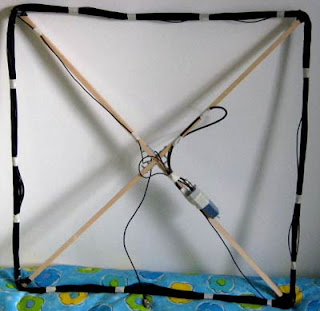Posts Tagged ‘dk7fc’
 How Low Can They Go!
How Low Can They Go!
 |
| courtesy: Roger, G3XBM |
For the past few years several amateurs in Europe and along the east coast of North America have been experimenting on the ‘dreamers band’, 8.7 - 9.1 kHz.
Some rather surprising distances have been covered on these frequencies in spite of the dreadfully poor efficiencies realized with backyard antenna systems.
Previous 'earth-mode' backyard experiments on VLF by Roger, G3XBM, are well documented on his website along with details on his simple homebrew gear used to send signals across town using the earth. Following Roger's steady progression via his previous blog spots makes for fascinating reading ... there is some really great stuff here making it difficult to not jump in and take the plunge yourself.
This experimental field presents the ideal opportunity for a couple (or several) local amateurs to work together at exchanging signals on these low frequencies with simple home built equipment.
A major contributor to the present state of the ‘VLF / ULF amateur art’ is Stefan, DK7FC and a posting this week to the old RSGB's (blacksheep) LF reflector makes some of his earlier work pale by comparison as he announced the reception of his 270Hz signal (the 1110km band!) at a distance of 177 km!
Just a note from a recent experiment at 270.1 Hz.
On Sunday morning, 2019-05-12_10:34,+150m, I've done a carrier transmission on my ground loop antenna again. I did not expect more than, hopefully, a detectable spectrum peak in 57.6 km distance, i.e. at my tree site. The tree receiver site was listening and recording data using vlf-rx tools.
One E field antenna and two orthogonal loops were listening. The loops have been improved recently! They consist out of a single circular turn of 1.2 m diameter using 10mm diameter copper tube (about 25 mm^2). It is a closed loop, non-resonated, with an impedance matching transformer. This transformer previously had 1:100 turns. Now it (they) has 2:240 turns, i.e. two turns primary (out of 14mm^2, AWG6). This improved the sensitivity below 2 kHz significantly ( abt. 4...5 dB).
Furthermore the TX antenna length and angle has been improved, resulting in about +3 dB more signal strength on the RX site!
In a previous experiment at 270.1 Hz, some month ago, there was no result at all, not the weakest trace, despite excessive tweaking of all parameters. So the question was, will the improvements result in a detectable signal now?
Several things went wrong in that experiment. I forgot a bag containing important equipment such as the power supply for the netbook that generates the carrier signal. Also the output power was not as high as planned, just about 380 W, giving 2.2 A antenna current (I measured 64.7 V at 1 A DC). Anyway i managed to improvise so the experiment was started, but with some hours of delay which meant i higher QRN background level. Then, on the WLAN link to the tree, there were several interruptions of the stream (i'll move to 5 GHz very soon!). I even got some QRM from my battery charger for some short time periods (forgot to disable the charger remotely). So there were several factors that could have been improved or avoided. And the middle of May is not the ideal time anyway.
Well, 270.1 Hz, that's the 1110 km band! The far field begins at 177 km distance, i.e. i am clearly in the near field here. Thus, from a 'magnetic' TX antenna, we would expect that the signal is mainly detectable on the H field, i.e. the loop antennas.
The first interesting results is that this expectation is actually confirmed. There is nothing detectable on the E field but the carrier S/N in the H fields is close to 10 dB in the first run. Mixing the H fields and tweaking the filters rises the carrier S/N to 10.7 dB, see attachment.
So far not really an undoubtedly detection but it is a candidate for optimism! With a few less problems during the experiment there is a chance for 14 dB SNR. Also, there is quite much sideband QRM around 300 Hz which makes 270 Hz a bit harder to work on.
73, Stefan












